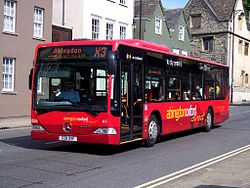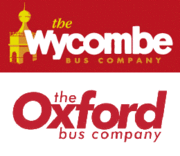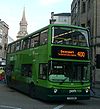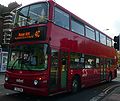- Oxford Bus Company
-


An Oxford Bus Mercedes-Benz Citaro in OxfordSlogan "We're all about Oxford" Founded 1881 Headquarters Oxford Service area Oxfordshire, England Service type Mainly urban bus services Destinations Abingdon, Didcot, Kidlington, Oxford.
Express services to London, Heathrow, GatwickFleet 149 Operator Go-Ahead Group Web site www.oxfordbus.co.uk Oxford Bus Company is a bus operator serving the city and surrounding area of Oxford, England and is the trading name of City of Oxford Motor Services Ltd. It is now a subsidiary of the Go-Ahead Group. The company operates five different brands.
Oxford is one of the few UK cities where such free and unsubsidised competition (as envisaged by the architects of bus deregulation in the 1980s) still exists. Similarly the Espress buses compete with the Stagecoach in Oxfordshire's Oxford Tube service. This unusual level of both service and competition is facilitated by Oxford's status as a prestigious university city and the consequent large numbers of young, affluent but car-less inhabitants, assisted by Oxford’s pro-public transport Balanced Transport Policy of 1973 and Oxford Transport Strategy of 1993. As of 2006 public transport use in the city was six times the national average.[1]. However, the competition led to route inefficiencies and lack of ticket interoperability between bus operators. In 2010 it was announced that a quality contract had been agreed between the two principal bus operators and the County Council leading to joint timetabling and ticketing.[2]
Contents
History
A horse-drawn tram system first operated in Oxford from 1881.[3] Its operation was taken over in 1906 by the City of Oxford Electric Tramway Company Ltd. This did not in fact electrify the tramway, but over the period 1913-14, and under threat of competition from William Morris (later Lord Nuffield), replaced the trams by Daimler Motor Company buses.[4]
In 1921 the company was renamed City of Oxford Motor Services Ltd and continued to expand its operations into the surrounding countryside. From the 1930s the company was controlled by British Electric Traction with a large Great Western Railway shareholding. Most of the fleet comprised AEC vehicles in the traditional red livery with green and maroon relief.
On becoming a subsidiary of the National Bus Company in 1969, moves towards greater integration of city and country services began. In 1971 the Oxford to London coach operator South Midland (established as South Midland Transport & Touring Company Ltd in 1921), which had been controlled by the neighbouring Thames Valley Traction company, was transferred to City of Oxford and the fleet name for the entire operation became Oxford South Midland. A particularly acute problem for the operator was the competition for staff with the Morris Motor Company whose works was located close to the Oxford garage. One solution was the move to one person operation of buses during the 1970s.[5] Following several trials, the Oxford company has operated the city’s pioneering park and ride bus services since 1978, the year in which the London express service on its present routing began.
In 1983 the operation was split into separate Oxford and South Midland units. The Oxford Bus Company was allocated the Oxford city services and the London routes, and South Midland was allocated the remainder of the network. Both companies were subject to management buyouts. The South Midland company was soon resold to Thames Transit (later Stagecoach) who introduced minibus competition, countered by the Oxford Bus Company under the brand name Oxford City Nipper.
In 1990 the Oxford Bus Company acquired the High Wycombe operations of the Bee Line, and ran them under the Wycombe Bus brand name. OBC was sold to the Go-Ahead Group in 1994. In 2000 Go-Ahead sold the High Wycombe operations to Arriva, who dropped the Wycombe Bus brand. In Oxford the name City Line was used before the present branding was adopted in 2000. The company's long-standing main depot site in Cowley Road, Oxford was abandoned in 2004 in favour of a new works in Watlington Road.[6]
Recently, the Oxford Bus Company have replaced some of its older buses with the Mercedes-Benz O530 Citaro. Another 11 arrived at the end of 2006; these were "Euro V", a higher specification than at that date demanded by European emission standards.
Brands
Oxford Bus Company currently operates services under five distinct brands:
Brand Used for Services Image Oxford Bus Company / "City" Local buses in and around Oxford. The "City" name has been introduced recently for the most frequent services, and the name appears on the sides of buses. At first designated to specific routes (i.e. "city 5") most buses now only display the general name. All other normal bus services Park & Ride Express buses from the well-developed network of peripheral park and ride car parks around the city. 300, 400, 500 Oxford Espress Express coaches between Oxford and London X90 Airline Express coaches between Oxford and London Heathrow or London Gatwick airports. X70, X80 BROOKESbus Local buses serving the campuses and halls of Oxford Brookes University (previously run by Stagecoach Oxfordshire). U1 (NU1), U4, U5 (NU5), U5X Fleet
The fleet consists approximately 160 operational vehicles as of January 2009, consisting a wide variety of bus makes and types. The fleet is about 56% single-deck and 19% double-deck. Coaches make up around 25% of the fleet.
The single-deck fleet contains a number of types. Three comparatively rare Dennis Dart SLF/Wright Crusaders were new in 1998. Two large batches of Volvo B10BLE/Wright Renowns in 1999 and 2000 total 21 of the type. In late 2002, the first of a batch of 5 Mercedes-Benz Citaros arrived for new park and ride service 500 to the recently opened Water Eaton site. Following a fleet reshuffle which saw service 500 receive double decker buses, this fleet now all carry the standard 'city' livery. The original batch can be distinguished by the protruding destination display, all other examples in the fleet have swept back versions. A year later in December 2003 a further batch of 11 Citaros arrived, branded for routes X3 to Abingdon. Another batch of 10 arrived in December 2005 for route 2, followed by another 11 in December 2006. 11 more arrived in January 2008. The 2006 batch onwards is to the new Citaro design for the Euro 4 engine, although the Oxford examples are to Euro 5 specification. Half of the 2006 and the 2008 batch are branded for routes X3 and X13, which meant that the second batch were debranded and now work in generic livery.
The double-deckers in the fleet are Dennis Trident 2s. A batch of 20 with Alexander ALX400 bodywork entered service in 1999. These were some of the first examples of the type. Originally 14 of the batch operated on park and ride services but are now being phased out in favour of 17 new diesel/electric hybrid ADL Enviro400H models[7]. In 2007, 8 Tridents with Plaxton President bodywork were transferred from Go North East for use on route 35/35A. These are restricted to certain routes as they are too high to fit under the Oxford station railway bridge.
Also the double-decker fleet includes 31 Scania N230UD with Alexander Dennis Enviro400 bodywork used for Brookes Bus services.
The large coach operation uses 37 vehicles. The Oxford Espress service uses most of a total of 12 (two batches in 2003 and 2004) Scania K114s with Irizar Century bodywork, as well as 6 2002 Volvo B12Bs with Jonckheere Mistral bodywork. The Airline uses a fleet of 19 Volvo B12B/Plaxton Panthers new in 2008, as well as some of the Scania K114s.
Fleet summary
Coaches Chassis Count Body type Image(s) Scania K114 12 Irizar Century Volvo B12B 6 Jonckheere Mistral Volvo B12B 19 Plaxton Panther Double-deck Chassis Count Body type Image(s) Dennis Trident 2 20 Alexander ALX400 Dennis Trident 2 4 Plaxton President Scania N230UD 31 Alexander Dennis Enviro400 Single-deck Chassis Count Body type Image(s) Volvo B10BLE 31 Wright Renown Mercedes-Benz Citaro 48 Integral See also
References
- ^ Harris, Chris (2007). Exploring Oxford Bus Company country. Kettering: Past & Present Publishing. p. 7. ISBN 978-1-85895-256-7.
- ^ Little, Reg (2010-01-14). "Historic bus deal boosts city services". Oxford Times: pp. 1.
- ^ A History of the County of Oxford: Volume 4: The City of Oxford; Oxford Bus Company: history
- ^ Oxford Mail: Postcard marked passing of Oxford's trams; 10:00am Monday 15th March 2010; OXFORD AND DISTRICT TRAMWAYS BILL. (By Order.) HC Deb 22 July 1914 vol 65 cc591-9 591
- ^ Jolly, Stephen and Taylor, Nick (2003). The Book of Oxford Buses and Trams. Oxford Bus Museum Trust. ISBN 0-9506739-2-7.
- ^ Ashworth, Phil (2006). The Oxford Bus Company — the first 125 years. Oxford Bus Company.
- ^ www.busandcoach.com/newspage.aspx?id=5382&categoryid=0
External links
Go-Ahead Group United Kingdom
bus companiesBlue Triangle · Brighton & Hove · Damory Coaches · Docklands Buses · Go North East · Konectbus · London Central · London General · Metrobus · Oxford Bus Company · Plymouth Citybus · Solent Blue Line (Bluestar, Uni-link, Marchwood Motorways) · Southern Vectis · Thames Travel · Tourist Group · Wilts & Dorset (services)


United Kingdom
railway companies
(Govia)Defunct UK
operationsCategories:- Coach operators in England
- Bus operators in England
- Go-Ahead Group companies
- Transport in Oxfordshire
- Transport in Oxford
- Former nationalised industries of the United Kingdom
- Companies based in Oxford
- 1881 establishments in England
- Companies established in 1881
Wikimedia Foundation. 2010.




















